My Bavaria is a real character (in a movie)

In late spring of 2022, I received an interesting email:
“I am a writer/filmmaker looking for a 1974 (or so) BMW Bavaria to use in an upcoming short film. I saw The Hack Mechanic piece about yours and wonder if you still have it or know somebody who does and would be willing to loan or rent it? Any help or advice you may have would be hugely appreciated. I look forward to hearing from you. Many thanks and my best.”
I googled the sender and found that she was for real—she is a New York Times–reviewed author of several novels, one of which was made into a film. I responded that, yes, I still have the Bavaria and we could probably work something out, but she should know that it’s a ’73, which is a small-bumpered car, whereas the ’74 she asked about is big-bumpered, so if the film was about Jackie Onassis, who famously owned a green ’74 Bavaria, mine looks a little different. She replied that, while there is a reference in the script about Jackie O. owning the same model, but the film isn’t about her, so the difference isn’t important.
We swapped a few more emails, then spoke at length on the phone. She told me the outline of script, which involves a young woman finding the car in the driveway of a house and feeling drawn to it, then learning that the car was owned by a man’s wife who passed away under mysterious circumstances. I said that my Bavaria may have been destined for this part—after I bought it from a guy who’d picked it up at an estate sale, I learned that the owner before him had apparently ended his life after his wife died under mysterious circumstances.
By the time the call was over, we’d done the writer-to-writer secret handshake and I verbally agreed to rent her the car. She said that shooting was slated to happen in New York’s Hudson Valley the first week of June, she’d gladly pay for rental and shipping, and she’d hand me over to her producer to work out the specifics.
Several emails and phone calls ensued with the producer. While I’d loaned out my BMW 2002s for weddings, this was different—this was a commercial venture for which I’d need to be certain about insurance. “We have prop insurance for the film,” he said. That didn’t sound adequate to me. “I think I’ll need to find out what’s involved with my own insurance company.”
So I called Hagerty. It was very straightforward. I was told I’d need to add a commercial rider to my policy. For the modest insured value of the Bavaria, the cost for a commercial rider was $50 for the year and covered up to four events, each up to three days long. All that I needed was the shoot dates and a scan of the driver’s license of anyone slated to drive the car.
Regarding transport, the car was currently in the warehouse in Monson, Massachusetts, making shipping non-trivial. That is, I couldn’t simply give that address to a shipper; I’d need to be there to bring the car out. I first thought the thing to do was to grab the Bavaria from the warehouse myself and bring it to my house in Newton so that a shipper could load it there. I got a one-way shipping quote of $450. However, the more I thought about it, the more I realized that commercial shipping probably wouldn’t work. If you’ve shipped cars, you know that it’s not like making a dentist appointment; you can’t realistically expect pick-up and drop-off to be on a specific day and time. It’s whenever they get there. I may not care if a car is delayed a day or two or seven, but a film crew sure as hell would.
Regarding a daily rental fee, I asked the producer to tell me what was reasonable and customary. I never heard back from him on this point, so I did some web-searching. I found posts on vintage car forums that ballparked it as $100–$200 if the car is basically an automotive extra parked on the street, but potentially thousands of dollars if the car is rare, valuable, and used more like a character in the film. I also read some alarming things about cars and movie shoots, warning that, regardless of what you write into a contract, there’s no way to guarantee that every person on the set has the same regard for your baby that you do, so if you’re not there every moment monitoring their actions, you’re taking on risk and may not like the result.
The filmmaker emailed me saying that the shoot date and location had been nailed down—early June at a large modernist house in upstate New York. When I Googled it, the first hit was Airbnb, which listed the nightly rental at nearly what I’ve paid for many of my cars.

I’ll freely admit that my reaction was “OK, these folks have a decent budget for this film. It’s appropriate to charge them market rates.” Cost to rent the Bavaria? From the filmmaker’s description, it sure sounded to me like it was going to be used as “a character in a film.” I set the rental fee at $500/day. Transportation costs? In order to assure the car was there at the appointed day and time, I saw no other option than for me to be the shipper—e.g., rent a U-Haul trailer Sunday night, pick up the car at the Monson warehouse as early as possible that Monday morning, drop it off at the film shoot, and reverse the process two days later. Since this was going to involve a lot of my time, I multiplied the $450 shipping estimate by four (I’d need to go back and forth four times) and quoted $1800—still cheaper than anyone else would charge for shipping and pickup with guaranteed arrival dates and times. I wrote up a simple Memorandum of Understanding (more than a phone call, less than a formal contract) listing those rates, as well as other caveats like no adhesives could be used to affix cameras, suction cups only on the glass, and that they’d have to pay for any additional expenses including damage below my deductible, and emailed it to the producer.
To my surprise, it went tilt. He called and said, “We just don’t have that in our budget.” I said that I saw the Airbnb rate for the location, so it was difficult to believe that they were doing this on a shoestring, and I reminded him that the filmmaker had contacted me and that the both of them had agreed to the rental and had offered to ship the car.
Then he said something surprising: “There’s a guy near here offering to rent us an old Mercedes for $500 for the day.” Wait, what? Before I became a full-time writer, I was an engineer for 35 years, so I’m used to thinking in terms of requirements. I replied, “Is a BMW Bavaria required for the shoot or not?” The producer said, “Well, she certainly wants it.” We went back and forth, with me saying that the logistics of my getting them the car on time for a three-day shoot would occupy much of two of those three days.
Finally, the producer said, “Is there any way you could just drive it here for a day for $750? We could go as high as a thousand. And we could put you up overnight if you’re here too late to drive back.” I thought about it, and said, “Yeah, if it’s really a one-day shoot, I can do that, but if it rolls into a second day we’d need to renegotiate. And I can’t go out there expecting one day and have it turn into three.”
But then there was an even bigger surprise. “We’re not sure if the actress can drive a stick,” I was told. “You don’t have one of these cars with an automatic, do you?” I don’t recall what I said, but I’m sure I stifled what I really wanted to say.
We left it that the actress-maybe-not-driving-a-stick thing definitely needed to be resolved, but yeah, sure what the hell, $750 for one day, more if it rolled over into the next day, plus expenses, with some caveats. I rewrote the Memorandum of Understanding. The producer signed it. We were on. I called Hagerty and paid for the insurance rider, then texted the guy who owns the warehouse in Monson asking if he could meet me there at 6:30 a.m. on a Monday in early June so I could grab the Bavaria. He said he’d be unavailable but gave me the combination to the locks on the gate and the warehouse door.
Let me take a step back for a moment. There are many things in life that you can make as simple or as complicated as you want. This was one of them. Even the issue of the non-stick-driving actress notwithstanding, I really don’t know how you would do this in an iron-clad fashion without a lawyer. I was aware that I had absolutely no bona fides on what “studio” was making this film, or on this producer who’d signed my flimsy little Memorandum of Understanding. But to quote the great philosopher Peter Griffin, “Sometimes in life you gotta say, ‘What the hell,’ and just go for it.”
A few days later, the producer emailed me saying he confirmed that the actress was stick-capable. He also attached the required scan of her driver’s license, which I forwarded to Hagerty.
Anything can go wrong with a 50-year-old car, so I packed the trunk of my BMW E39 530i with spares for the Bavaria as well as jumper cables and starting fluid. I even packed a small floor jack in case I had to change a flat. I arrived at the warehouse around 6 a.m. on Monday, reconnected the Bavaria’s battery, and filled the dried-out float bowls of the twin Weber 32/36s with perhaps 20 seconds of on-off cranking. The car settled into a lumpy idle that smoothed out as it warmed up. I locked up the warehouse, texted the filmmaker that I was on the way, and hit the road.

As soon as I began driving, though, I caught an unmistakable whiff of the sweet smell of antifreeze. Damn. I stopped and checked, but I didn’t see any coolant dripping. The translucent overflow tank, though, was a bit low. I bought a gallon of pre-mixed antifreeze at the first open convenience store and topped it up. Over time, the smell lessened. I watched the temperature gauge like a hawk, but it stayed cool. I’m still not sure what caused the smell. I eventually relaxed and enjoyed driving the Bavaria out the Mass Pike through the Berkshires, then down New York’s lovely Taconic Parkway.
I arrived at the mailbox to the shoot location at 8:15 a.m. and drove slowly up the long winding gravel driveway that snaked up the hill to the house. The filmmaker came out and greeted me. She marveled at the car, particularly its intact original tobacco interior.

Unfortunately, she then shared some less-than-thrilling news: The actress could barely drive a manual transmission. I thought about it carefully, and decided to see for myself. I met the young woman who was slated to drive the car.
“Tell me about your manual transmission experience,” I said.
“I have driven a stick before,” she said, “but I don’t do it often.”
“When was the last time you did it?” I asked.
“Yesterday.”
Out of decorum, I did not ask if “yesterday” was the only time she’d ever driven a stick.
“I won’t burn out your clutch,” she said.
I thought about it. “Good answer!” I replied.
There was a 20-minute window before filming was scheduled to start, so I took the actress out on the long gravel driveway for a short lesson. She did OK, not unlike my kids when they were learning. Her main problem was releasing the clutch too quickly, which is better than feeding way too much gas. And the gravel driveway was fairly forgiving, as when she let off the clutch too fast, the rear tires just kicked up stones. I showed her the trick of using the handbrake to get started on a hill, but that’s something that takes a lot of practice.
I was keenly aware that I was in an awkward position, as saying “no” would’ve ground things to a halt and cost the filmmaker thousands of dollars. At some point, you make a gut-level decision about these things. The Bavaria is not a high-dollar car. It’s not precious to me in the way my 3.0CSi is. The actresses’ clutch skills were passable. The car’s transmission and clutch are pretty stout. Nearly the entire shoot was going to be on the gravel driveway. It was less than ideal, but here we were. Onward.
By the time we finished the lesson, everyone was there. Between the actors and the crew, there were probably 15 people. The only thing similar I’d ever done was the video shoot with Magnus Walker. This was bigger—more people, video and film cameras, a drone, a script, and actors with lines.
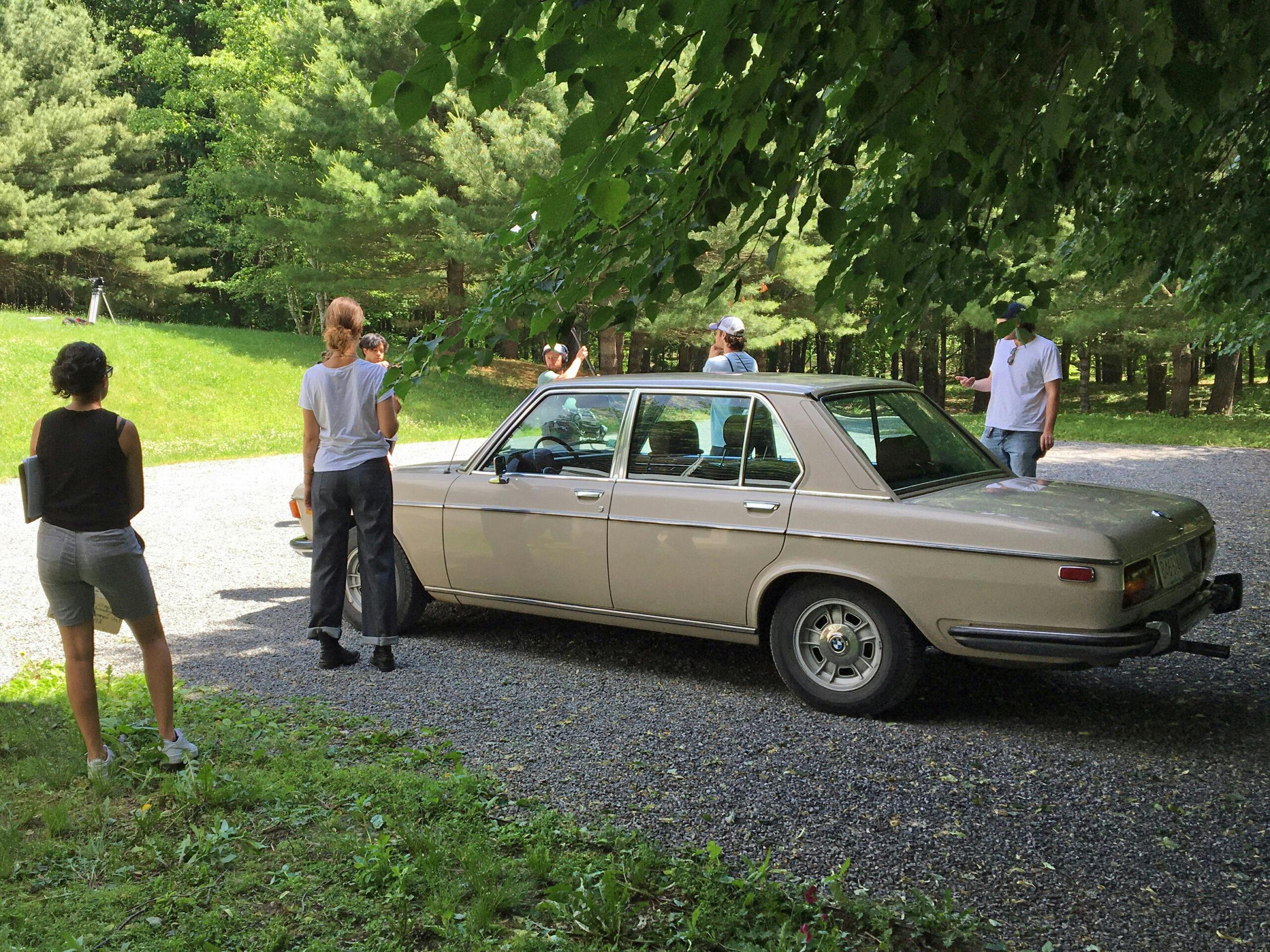
Nearly everyone on the crew loved the car and treated it very carefully, with one glaring exception—a young woman who put both her clipboard and clapperboard (the thing where you go “Scene 4, Take 2, action!” and slap it closed) on the trunk lid. The filmmaker immediately corrected her. The young woman distractedly nodded but didn’t remove the items. I approached her and gently said, “You can’t put hard objects on the paint of a car like this.” She removed them but made no apology. I let it go. The filmmaker witnessed this, walked back over, looked at the trunk lid, pointed to a long faint superficial scratch, and asked, “Was that already there?” I said, “I’m pretty sure, yes.” As I said, you can make things as simple or as complicated as you want.

Since the crew was planning on having the Bavaria for only one day, all filming centered on it. The first shot had the car sitting under a cover. The filmmaker had asked me to bring the thin cloth cover that I used in the warehouse. Although it was unrealistic for real outdoor storage, it draped nicely on the car. She was attracted to the idea of yanking the cover off like a magic trick or a tablecloth from under dishes and glasses. Unfortunately, there were too many snag points for that to happen. They then tried a single graceful sliding pull, more like a nightgown falling over shoulders, but the cover got hung up on the rear corners of the drip rails. I put electrical tape over the ends of the rails, making little ramps for the cover to slide over. This actually worked, but the cover then snagged alternately on the antenna, mirror, and wipers. After multiple takes threatened to blow the shooting schedule, the cover was removed by less sensual methods.
Next were the driving shots. The actress was still coming off the clutch too quickly, making little chirps in the gravel. I went into dad mode, encouraging her, complimenting her, and keeping my cringing to myself, but the film crew thought the little peel-outs looked cool. A video snippet of one of them can be seen below.
One of the driving shots was slated to use a “hostess tray”—a large apparatus that hung on the passenger door and held a film camera aimed at the driver. I inspected the hardware and noted that it used four round discs, each about two inches in diameter, to support the tray against the door skin. It looked like each needed a rubber pad much larger than the ones that were on them. The cameraman admitted that they’d normally use big thick rubber squares, but they didn’t have any. “We’ll mount the whole thing on a furniture blanket, then put towels under each of the discs,” he said. “I’ll need to judge it for myself,” I explained. I put the furniture blanket on the door sill, began to lift the hostess tray onto it, realized that it weighted at least 35 pounds, put it back down, and simply said “No.” They strapped the hostess tray onto a rental car instead and got the shot by driving alongside the Bavaria.

Filming ran all day. After the final shot was complete, the filmmaker reported that a piece of the inside rear door handle connecting the rear armrest/door pull to the door had broken. She was livid and apologetic, and immediately said she’d pay for it. I looked at it, thought, and shrugged. “It’s a 50-year-old piece of plastic,” I said. “We’ll work it out. It’s probably no longer available. I’ll probably just glue it, then never look at it again.” (It turns out it is available, but only in black. However, a little reinforcing bracket is available that’ll help keep it together after I glue it. I charged her for the bracket.)
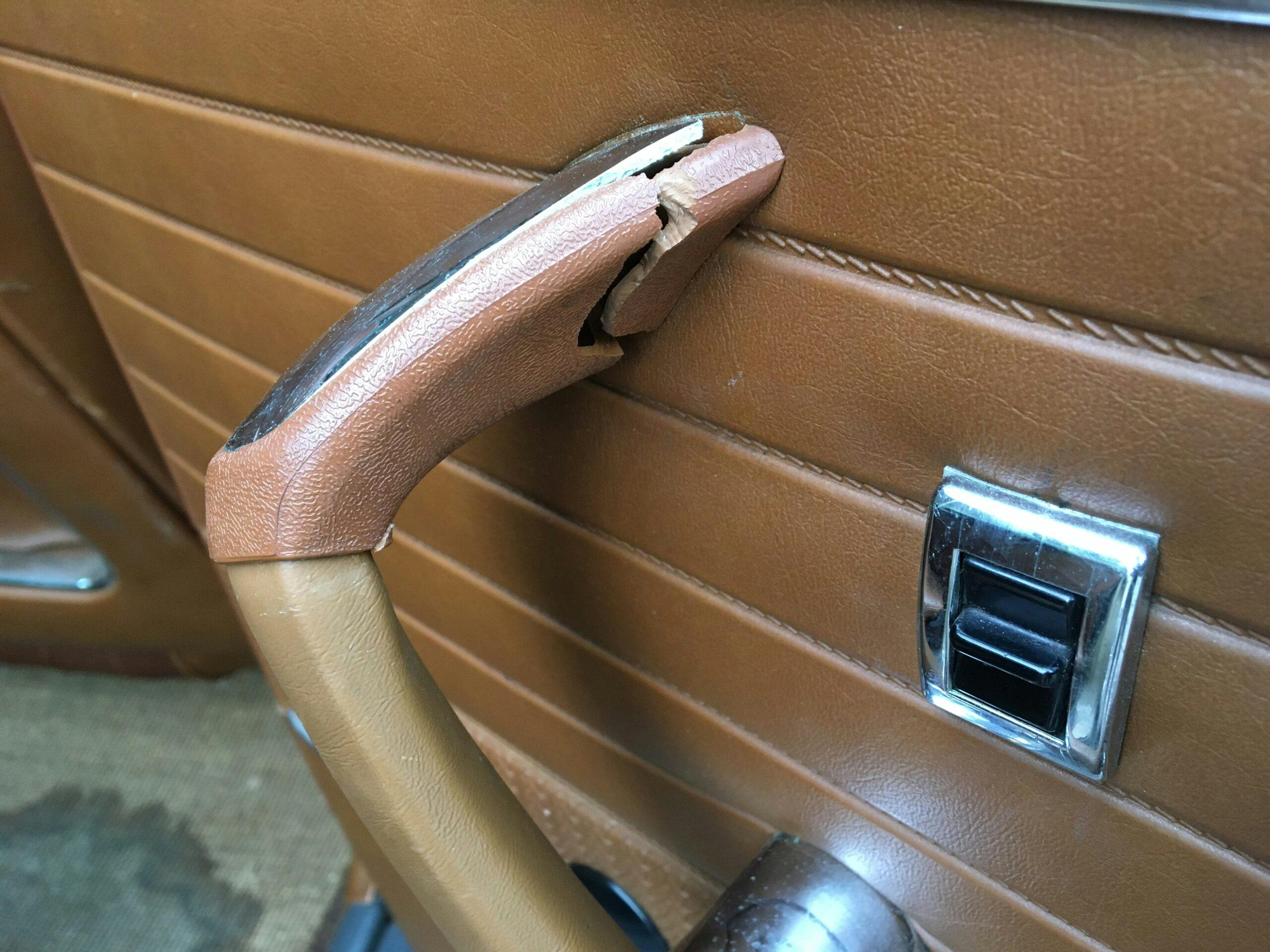
With the car’s part of the shoot over, the filmmaker expressed deep gratitude. I ate dinner with her and the crew, then crashed for the night on a spare mattress in the big modernist house. I woke up early and drove the Bavaria, its clutch and transmission apparently no worse for the wear, back to the Monson warehouse, retrieved my E39 sedan, and headed home. A few days later, a check arrived for my agreed-on expenses.
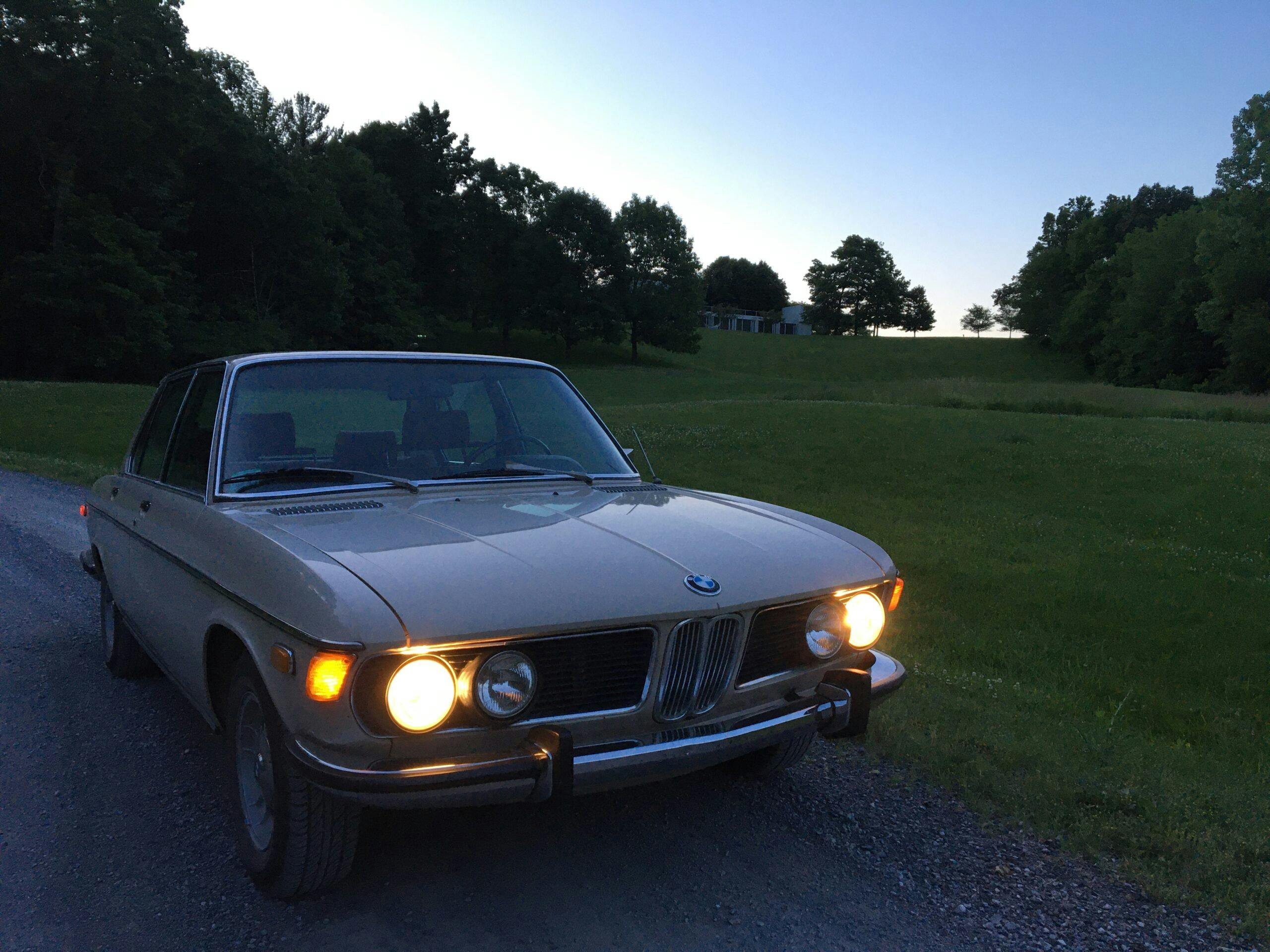
So, was it worth it?
For me, yes, absolutely. I like to say “yes” to things as often as I can. And I took a lot of pride in enabling this fellow writer’s shoot by providing her with the car she wanted. Speaking with her directly on the phone first, then meeting her and liking her, then having her be so grateful were key. The fact that no one else would’ve done what I did—rented and delivered the car himself for such a modest sum, not bailed on the business of the barely-stick-driving actress—made me feel good. I can’t fix this broken world, but I could do this one kindness for this one writer/filmmaker. One cracked plastic armrest piece doesn’t change that one iota.
I recently learned that the film was nominated for best mythical/spiritual short at the 2022 Cannes World Film Festival. However, as I haven’t yet heard directly from the filmmaker, it would be improper of me to release the film’s name or post a link.
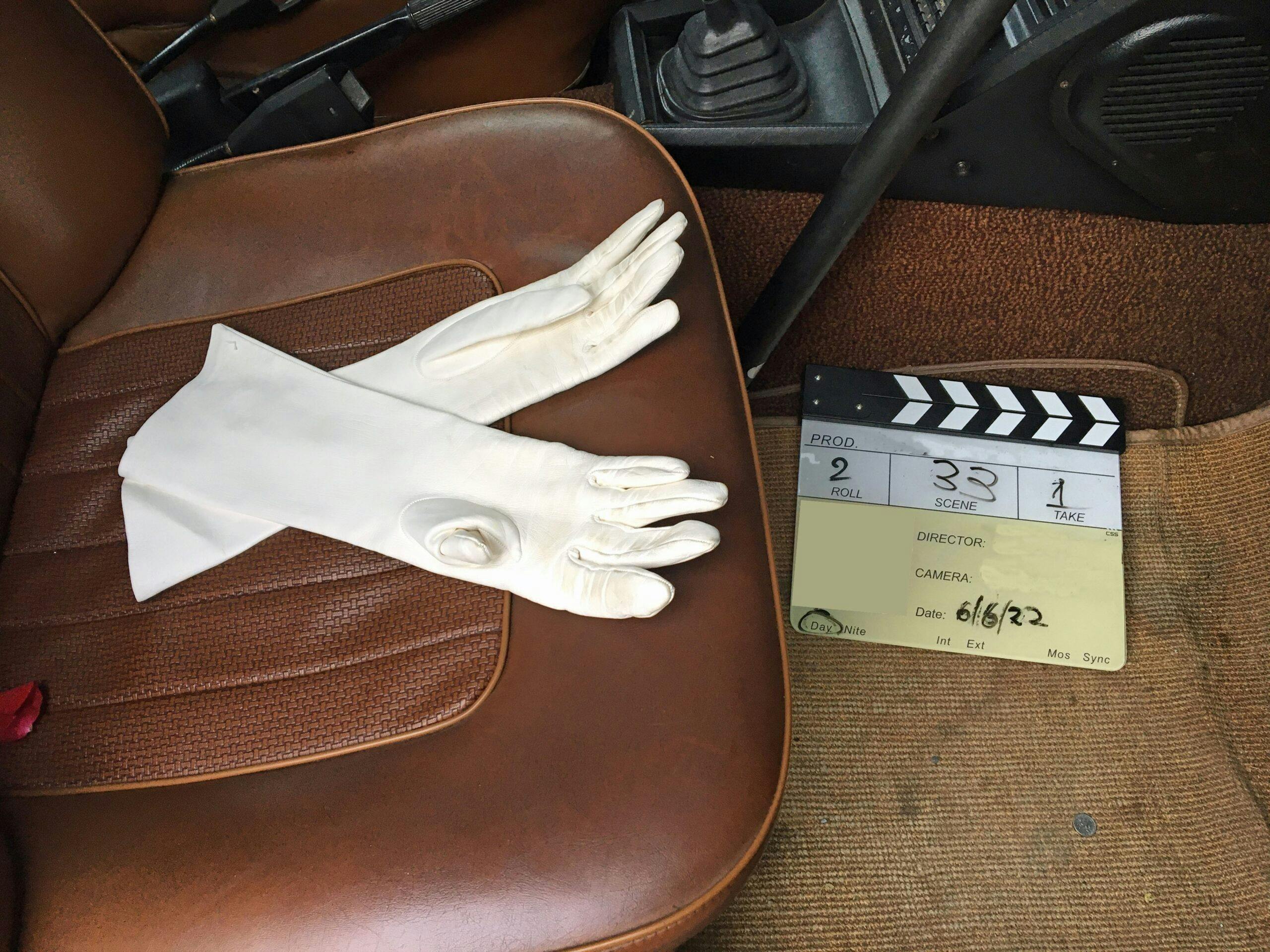
If you’re reading this and screaming “Are you freaking nuts? I would never let someone do those things to my car,” that means that if someone is asking to rent your prize for a movie shoot, you should say “no.” And that’s OK.
But if you do choose to do this, know that there’s a very straightforward mechanism within your Hagerty policy to cover the car.
The main takeaway message is that, if it’s a car that you care deeply about, I would strongly recommend that you state in writing what is and what isn’t allowed, and then require that you be on the set at all times to enforce it, and, if necessary, veto what they’re about to do.
And yes, if there ever is a next time, I’ll make sure that the actor/actress really knows how to drive a stick.
***
Rob’s latest book, The Best Of The Hack Mechanic™: 35 years of hacks, kluges, and assorted automotive mayhem is available on Amazon here. His other seven books are available here on Amazon, or you can order personally-inscribed copies from Rob’s website, www.robsiegel.com.
Check out the Hagerty Media homepage so you don’t miss a single story, or better yet, bookmark it. To get our best stories delivered right to your inbox, subscribe to our newsletters.
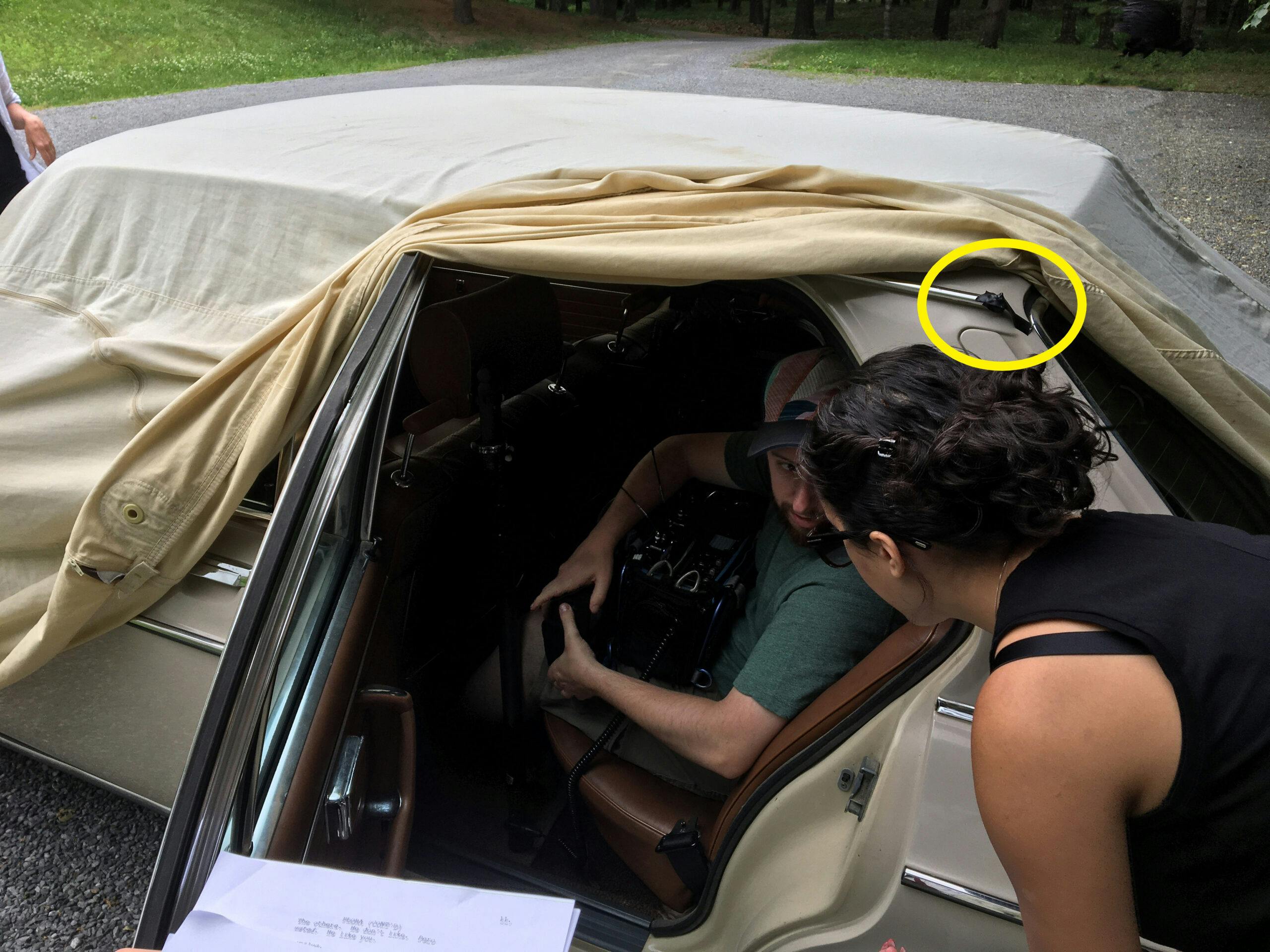
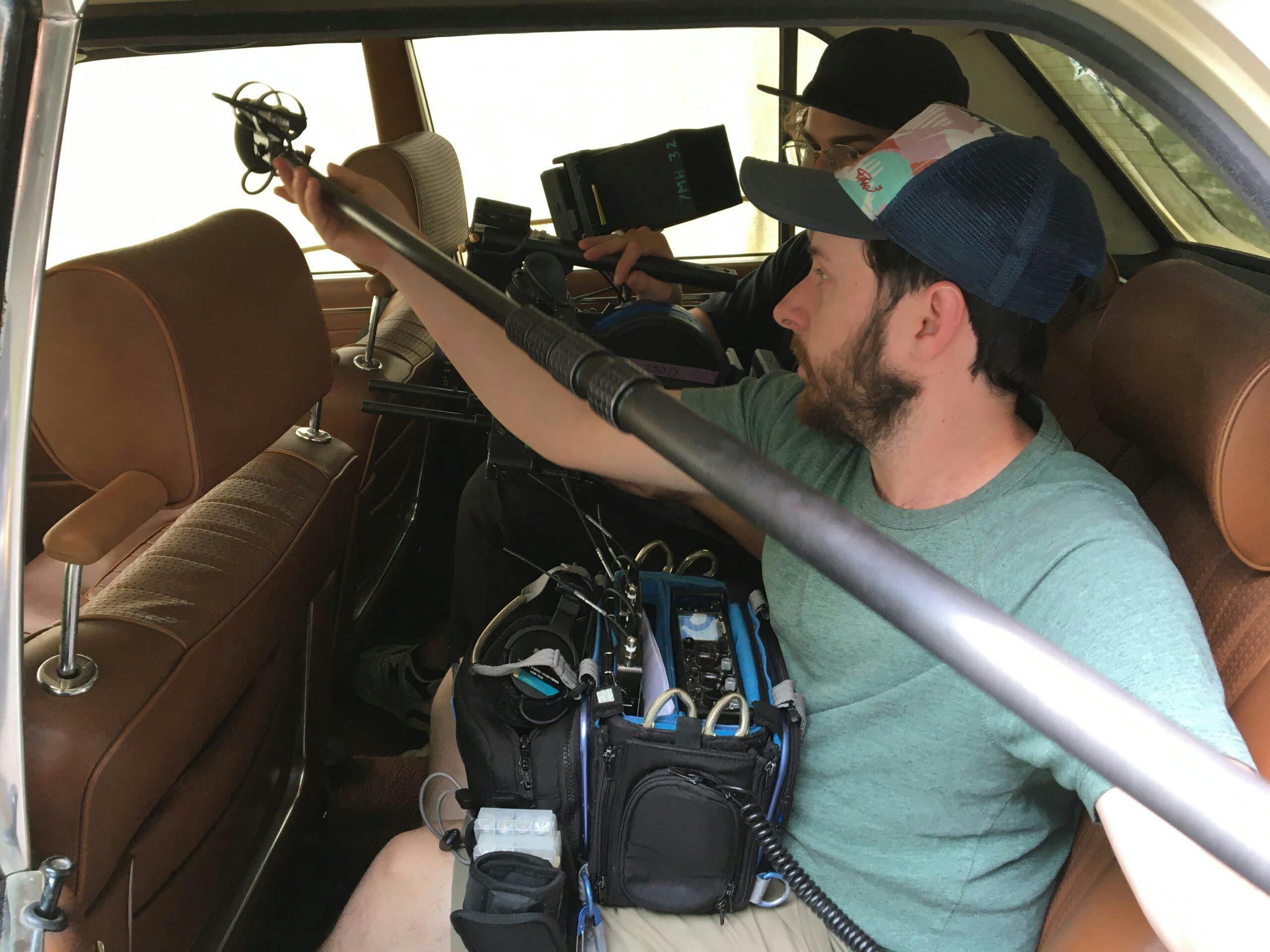


I sold Hondas in 1977 and we had a 1974 BMW Bavaria traded in for a Honda Accord. The customer got his Accord and a check for the difference and the sales manager promptly bought the car for $5k.It was an automatic and I loved how it drove.
I sold Hondas also, in 1981. We had a 74 Bavaria (in BRG) on the back (way back) line. I could have bought it and a 75 MGB with only 50K on the clock for $500 each. Sorry Merle but, yes, the good times really are over for good.
Rob great adventure, oh are you getting a commission for the product placement in you stories (Hagerty)? I have noticed a lot of references to your publisher in the last. Couple of stories. Just wondering…. Great that your car was in a short…
Interesting out-of-the-box car experience
Neat experience! Thanks for relating it so well, Rob – this is something that (I daresay) very few of us will ever get to do, so it’s great to get it in such detail. I give it THREE E’s = Educational, Entertaining, and Excellently written!
Rob, great story, one question, well really two. When was the last time you had this car out on a long drive? Second. If it had been a significant number of months. Were you not worried about various service component failures due to deterioration from sitting? Really three, also how old are the tyres, as after about four or five years modern tyres can come apart with out warning?
1) Depends what you mean by “long.” The car has been back and forth the 70 miles from my house in suburban Boston to the Monson warehouse several times.
2) I write a lot about “The Big Seven” things likely to strand a vintage car (fuel delivery issues, ignition issues, charging issues, cooling system issues, belts, clutch hydraulics, and ball joints), so while any “various service components” CAN fail, the things that are most likely to are pretty well known, and I brought spares for the most common ones (e.g. fuel pump, points, condenser).
3) I personally don’t live in fear that “after about four or five years modern tyres can come apart with out warning.” Yes, looking at tire reviews on Amazon, you can always find someone posting that a young low-mileage tire failed, but this is generally a small tail of the curve. I would never drive a car with cracked or dry-rotted tires any further than a few miles on local roads to a cars and coffee, and I would never drive a car with OLD tires (say, ten years old) on a high-performance driving event, but I’ve never had a non-cracked non-dry-rotted tire fail spontaneously during lazy highway driving.
I am riding around in a few cars with 10+ year old rubber on them. The Porshe I had hit the 15 year mark before they started leaking air out the sidewalls. I had a Buick with older rubber on it that developed a vibration on the highway. When I pulled over, it was obvious there were broken belts. The only car I have ever experienced catastrophic tire failure in was a low mile Hyundai where the tire blew apart, and the strip of tread pulverized the side of the car before I could pull over. Moral is any tire can fail, and older tires tend to warn you first
” I can’t fix this broken world, but I could do this one kindness for this one writer/filmmaker. ” In a weary world filled with increasingly angry people, I find this attitude refreshing/inspiring. This is a great story and especially fun for people who like “behind the scenes” stories! Well done, Rob.
Best Comment of the Day Award goes to Dave B! 🏆
Seconded.
Lots out there says “don’t do film shoots ever”. This was refreshing without glossing over.
—-
To a different comment: I actually like the references to Hagerty policies and how to do that “within in the rules”.
Ditto that! And Rob, thank you
Lots of karma points there for sharing your car.Nicely done Rob.
Years ago I agreed to become a production assistant on a college film student’s thesis project. I got to stage some simple car crashes, perform no frills repairs under pressure in the field, advise safety methods and even appeared as an extra falling down a small set of stairs. More hurrying up and waiting than I’d ever known but a terrific experience all around.
And: Didn’t Doc Brown say “What the hell?” before Peter Griffin?
“Didn’t Doc Brown say “What the hell?” before Peter Griffin?”
I believe you have me there!
Oh, my dad said it decades before either one of them (and your probably did, too)! 😁
I prefer the variant by used Miles Dalby from Risky Business………but that’s just me
Decades ago my red ’64 Caddy Sedan deVille was an extra for a Magnum PI episode, parked on a street somewhere in Honolulu with fake cardboard NY tags on it. Don’t remember the episode or how I found out about it, but I wasn’t paid, they just wanted lots of period cars to park on the street. I was a fan of the show but I never saw my car onscreen…
Cool story. Depending on what is required I might allow my car to be used in a movie.
What a timely piece! I was just contacted by a producer who wanted to rent my ’91 Corvette convertible for a movie shoot. Now I not only know what to do with Hagerty, but also what to request from the film maker.
It would be a bonus if you write a follow up and let us know how YOUR experience went!
I was contacted by the producers of the TV show “Billions” because they wanted my Bill Thomas Cheetah for a scene that was filmed in a warehouse on the river front in New York City. The Cheet5ah was in Anaheim, CA. They paid to have it shipped round trip and have me come to NYC. It was a memorable experience.
My wife’s car was a 99 Mercedes SL500 that we had listed for sale on Craigslist in 2022. I got a call from a film producer asking if they could rent it for a day to shoot a film in a city nearby. They were so vague about timing, price, who was driving, insurance, etc. that my wife just said “no”. Never did find out the name of the film, or what car they used instead…
Great story Rob. I agree with you – at some point you just gotta say “why not”…. I did this recently with several of my 20+ year old automotive treasures. Thanks for sharing….
I’ve rented 4 different vehicles to 4 different productions. Average base pay was $125 including me being in the background. Despite being on set for 20 + days you can see 1 car once for about a second. Still fun to do background work.
I recently lent my 1973 BMW 2002tii be used for a film, which is currently in post-production. The writer/producer saw it the garage where I store it and liked the Inka color (the director wasn’t Wes Anderson but the director’s films are known for his use of color pallets). The car was not driven but shot with two two young women talking in the front seat. To your point about the risk of damage, the sound man had a tool belt with a screwdriver that punctured the leather seat.
I wasn’t there at the time but the producer reported the damage was very apologetic and promised to pay for the repair. We found a good car upholstery shop which replaced the torn area with a perfectly matched panel. The producer paid for the repair as promised plus a little extra, so no harm, no foul. I did not charge them for the use of the car as it was shot locally and not a big inconvenience to me to loan it out. It’s good to know about the very reaonable Hagerty commercial rider should I decide to loan it out again.
P.S. I have torn the upholstery on a different car seat myself. Lesson: Do not keep screwdrivers in your pants pockets (or a tool belt) when you are working on your car!